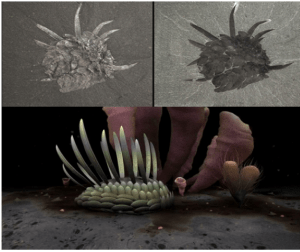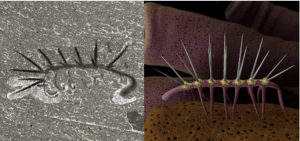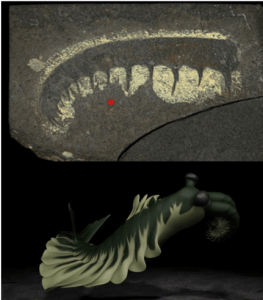Guest Author – Elvira Piqueras Ricote
Palaeobiology MSc Graduate
Whenever someone asks what I am studying at university and I reply with “Palaeobiology”, I get one of two possible responses: the first one is a very confused face through which I can see the person’s brain hard at work trying to figure out what that means, it has the word biology in it…but what on earth is Palaeo? The second one is “OH! DINOSAURS!”. Well, let me tell you a secret, I never actually liked dinosaurs. Don’t get me wrong, they are pretty impressive creatures, quite cool to look at, but that’s where my enthusiasm and interest begins and ends.
Most people don’t realise that palaeontology goes beyond scary big-toothed beasts, and that some of the most amazing creatures lived long before the first dinosaur crawled its way out of an egg (or however it decided to make an entrance). Let’s rewind for 541 million years, all the way back to the start of the Cambrian period, the COOLEST period.
The Cambrian is, without a doubt, my personal favourite and after you finish reading this post, I am sure it will be yours too, or at least make your top three. During the Cambrian, we see one of the most important events in the history of life on Earth, the Cambrian Explosion. It’s called an ‘explosion’ because there was a sudden increase in the number of species and of different body shapes, sizes, and weird body parts. To put it simply, before the Cambrian, we see pretty chilled animals munching on the seafloor, living their best life without a single worry, and then BAM! We start to see animals actively hunting, swimming away from predators, growing the craziest looking armours and things start to get fun (I guess that’s up for debate, but definitely more fun to look at).
Without further ado, I give you a few of the most popular Cambrian organisms found in the fossil record.
Wiwaxia – The Armoured Slug
This guy was found in the Burgess Shale deposit in Canada, where a lot of other Cambrian fossils have also been found. The Burgess Shale is what is known as a Lagerstätte or a site of exceptional preservation where specific conditions made it possible for organisms to be preserved in exquisite detail.
 Wiwaxia’s body, measuring up to 55 millimetres, was completely covered in sclerites (hard plates) which were attached to the body via root-like structures, with two rows of between 7-11 spines attached on the dorsal or top side. The only part of the body lacking sclerites was the ventral or underside where two rows of teeth are found. The sclerites offered Wiwaxia protection from predators swimming above it whilst it fed and crawled across the seabed.
Wiwaxia’s body, measuring up to 55 millimetres, was completely covered in sclerites (hard plates) which were attached to the body via root-like structures, with two rows of between 7-11 spines attached on the dorsal or top side. The only part of the body lacking sclerites was the ventral or underside where two rows of teeth are found. The sclerites offered Wiwaxia protection from predators swimming above it whilst it fed and crawled across the seabed.
You may think… NICE! But what actually is it? Well, the relationships amongst Cambrian organisms and how they are related to animals alive today is often a matter of debate. Because these fossils are so old, we may not have all the information necessary to be really sure of what they are and so it’s hard to assign them to a specific group, although it has been done for a number of them. Do not fret, however! As cutting-edge methods( known as phylogenetic methods) make the job a bit easier for us, we start to resolve and understand these relationships better – watch this space!
Hallucigenia – The Prickly Worm With Legs
No, you are not hallucinating (geddit?), it is also not a Pokémon or something out of Gene Roddenberry’s imagination. Hallucigenia was named after its “dreamlike” appearance, and rightly so.
Also found in the Burgess Shale, Hallucigenia is composed of a long ‘trunk’ with a head and mouth at the end of a long neck, reaching a total maximum size of 30 millimetres. The trunk is supported by seven pairs of spines on its dorsal side and seven pairs of leg-like structures on its ventral side which all end in a pair of claws: DO NOT POKE!
As in Wiwaxia, the spines would have protected Hallucigenia from potential predators and it most likely fed on sponges or perhaps animal remains on the ocean floor.
Although it is regarded as part of the group Lobopodia, we don’t know exactly where lobopodans fit within the animal tree of life and so it’s affinities (how it is related to other animals) remain controversial.
Anomalocaris – The Big Baddie
*Jaws soundtrack playing*
Move aside, T-rex, THIS is the scariest carnivore. Okay… it may look a bit like a prawn, but reaching a size up to 1 metre these guys were feared!
 Anomalocaris is part of the group Anomalocaridids which is related to the arthropods (insects, arachnids, crustaceans etc…). Its body, unlike Wiwaxia or Hallucigenia didn’t have hard, mineralized body parts because they didn’t need them. This carnivore actively swam through the water column with the help of at least 11 swimming flaps with gills and a tail fan composed of three pairs of fins. Its head was composed of two eyes on stalks (by the way, eyes evolved during the Cambrian, you’re welcome) and a circular plated mouth with spines oriented toward a square opening. It had 2 elongated trunk-like appendages at the very front each with a pair of sharp spikes. These would have been used to grasp its prey, most likely soft bodied trilobites (another very common organism found in the Cambrian fossil record).
Anomalocaris is part of the group Anomalocaridids which is related to the arthropods (insects, arachnids, crustaceans etc…). Its body, unlike Wiwaxia or Hallucigenia didn’t have hard, mineralized body parts because they didn’t need them. This carnivore actively swam through the water column with the help of at least 11 swimming flaps with gills and a tail fan composed of three pairs of fins. Its head was composed of two eyes on stalks (by the way, eyes evolved during the Cambrian, you’re welcome) and a circular plated mouth with spines oriented toward a square opening. It had 2 elongated trunk-like appendages at the very front each with a pair of sharp spikes. These would have been used to grasp its prey, most likely soft bodied trilobites (another very common organism found in the Cambrian fossil record).
Anyway
That was a very brief introduction to some of the organisms that arose during the Cambrian, but there are so many more you can learn about (a good place to start is on the Burgess Shale official website). You may have asked yourself why we see so many new species evolving during the Cambrian, why not before or after? Why do we see so many spiky and hard (biomineralized) structures? Well, it is likely that many factors where at play. The right environmental conditions may have allowed the right minerals to dissolve into the ocean waters which animals could have used to build up their armours, but why did they want armours anyway? This is due to another factor, the rise in predation, which started a race between predators and prey (or what we call arms-race): whilst predators evolved better structures to hunt, prey evolved better structures to defend themselves; a never-ending cycle. If you want to get a quick summary of potential causes check out this YouTube video I made when I first became interested in the Cambrian.
There are so many questions left to answer about the Cambrian period, the Cambrian Explosion, and the animals alive back then. But, isn’t it cool to think that some of the weird wondrous animals we see in the Cambrian were YOUR ancestors? I think by now is pretty clear that I absolutely love the Cambrian period and you should to! Whatever happened back then created the perfect opportunity for animals to explore new environments, niches, feeding and swimming strategies and therefore go from a fairly boring existence to a remarkably diverse and exciting abundance of life.
So there, the Cambrian is in fact the COOLEST period in the history of Earth and I dare you to change my mind.
About the Author
Elvira Piqueras Ricote completed the Palaeobiology MSc at the University of Bristol in 2020. Elvira’s Masters project focused on the enigmatic early Cambrian organism, Eolarva kuanchuanpuensis. Since graduating, Elvira now works as a science teacher in Clevedon where she continues to inspire the next generation of scientists. Elvira wrote this post whilst a student studying at the university.
Article edited by Mike Cawthorne and Rhys Charles
References
Philosophical Transactions of the Royal Society of London. B, Biological Sciences, 1985. The Middle Cambrian metazoan Wiwaxia corrugata (Matthew) from the Burgess Shale and Ogygopsis Shale, British Columbia, Canada. 307(1134), pp.507-582.
Briggs, D., 1985. Anomalocaris, the largest known Cambrian arthropod. Palaeontology, [online] 22(33), pp.631 – 664. Available at: <https://www.palass.org/publications/palaeontology-journal/archive/22/3/article_pp631-664>.
Morris, S., 1977. A new metazoan from the Cambrian Burgess Shale of British Columbia. Palaeontology, [online] 20(3), pp.623 – 640. Available at: <https://www.palass.org/publications/palaeontology-journal/archive/20/3/article_pp623-640>.

